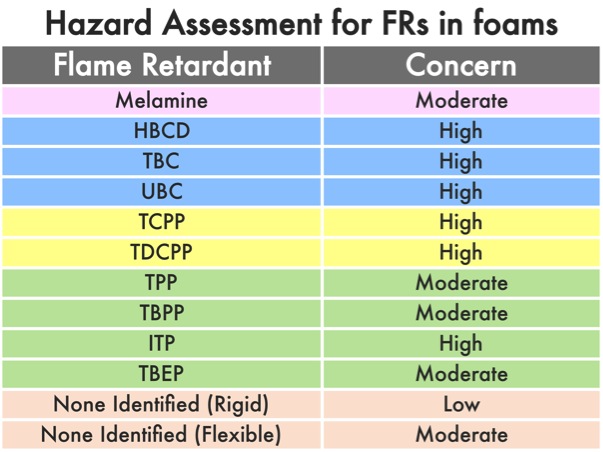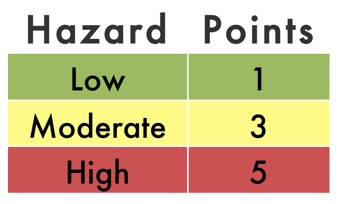Ranking System for 2014 Tested Children's Car Seats
To establish levels considered low, medium, or high for the chemicals of concern (several heavy metals as well as bromine and chlorine) measured as parts per million concentrations by XRF, HealthyStuff.org consulted existing voluntary product standards as well as mandatory toy, packaging, electronics, and vehicle standards. We also evaluated recent state and federal legislation regulating consumer products. The ratings are not intended to correspond to levels known to cause health effects. Rather, they provide a relative measure of the concentration of the chemical on or near the surface of the product.
The flame retardant chemicals identified by GC/MS were not quantified. We rated each chemical low, moderate, or high based on what is known about its potential to harm human health in low doses. To establish these ratings, HealthyStuff.org consulted many published research studies as well as hazard assessments carried out by government agencies. The ratings do not give a measure of actual chemical exposure from a car seat.
Most products we rate contain chemical hazards. Even the best of products often still contain some chemicals of concern. However, some products, like child car seats, are products that parents have to purchase for safety reasons. Therefore, we believe it is important to provide consumers with comparative ratings to allow them to assess the best and the worst of products on the market.
The car seat ranking system used three weighted components.
- Hazard assessment of specific flame retardants used in flexible and rigid foams (50% of ranking score)
- Company’s policy on phasing out brominated and chlorinated flame retardants (25% of ranking score)
- Presence of elements of concern in all materials and components (25% of ranking score)
Hazard assessment of flame retardants used in flexible and rigid foams (50% of ranking score)
Flexible and rigid foams in car seats are commonly treated with added flame retardants and make up a large volume of a seat. Every seat tested contained comparable flexible and rigid foam components, making possible a comparison of seats based on the chemical content of their foams. We assigned 50% of the ranking score to the hazard assessment of foams. Since specific flame retardant analysis was not carried out for all textile samples from the seats, we did not include textiles in this part of the ranking.
Flexible and rigid foams in the car seats were analyzed by GC/MS to identify known flame retardants. Specific chemicals were noted as detected or not detected in each material. A simplified assessment of chemical hazard—low, moderate, and high concern levels—was developed by reviewing authoritative lists and the scientific literature for each chemical (see the full technical report for an assessment of each chemical). These assessments should be considered provisional, as future research on these chemicals may refine our understanding of their specific hazards.
For each car seat, the highest hazard flame retardant detected in the rigid and flexible foams was identified and each foam sample was rated based on this flame retardant.
The hazards ratings were then assigned point values as given in the table below. Since one rigid and one flexible foam was assessed for each seat, the maximum possible number of points for a particular seat was 10 (5 points for high hazard in the rigid foam and 5 points for high hazard in the flexible foam).
Status of halogenated flame retardant phase-out in foams (25% of ranking score)
HealthyStuff.org asked car seat companies to eliminate bromine- and chlorine-based flame retardants after releasing its 2011 car seat study. For the 2014 model seats, a combination of elemental screening for bromine and chlorine and chemical identification using GC/MS were used to establish each company’s halogen phase-out status.
Car seats found to contain no bromine or chlorine were given a score of zero (0) and car seats containing one or more components with bromine or chlorine were given a score of five (5).
Presence of elements of concern in all materials and components (25% of ranking score)
HealthyStuff.org also conducted XRF screening on most major components in each seat. These included clips, straps, EPS and EPP foam, exterior plastic, interior plastic, polyester fiberfill, PU foam and textiles. We analyzed these materials for elemental composition (percent by weight or parts per million) for over 20 different elements. Based on existing regulatory standards and voluntary company supplier restrictions, we selected seven elements upon which to evaluate the products: arsenic, bromine, cadmium, chlorine, mercury, lead and antimony.
For each seat, the number of components containing one of these elements above the established threshold (listed below) was counted.
- >100 ppm: Arsenic, bromine, cadmium, mercury and lead
- >400 ppm: Antimony
- >2,500 ppm: Chlorine
The total count of components exceeding these concentration thresholds was considered the point total. For example, a seat might have bromine >100 ppm in one of its foams and antimony >400 ppm in its fabric. That seat would receive a point total of two. The point totals were then normalized to a 0 to 5 point scale based on the minimum and maximum points received by seats in our sample set.
Overall Comparative Ranking
Total points from all three factors were added together and normalized to a 0 (lowest concern or best product) to 5 (highest concern or worst product) ranking.




